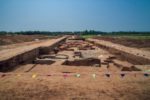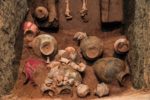They’re being called “giants,” because headlines and hyperbole would be lost without each other, but in fact the late Neolithic skeletal remains discovered by archaeologists in Shandong, eastern China, are more accurately described as having belonged to men of greater than average height. Some of them are very tall even by modern standards, and markedly exceed the current average height for an adult man in Shandong.
Measurements of bones from graves in Shandong Province show the height of at least one man to have reached 1.9 meters [6’3″] with quite a few at 1.8 meters [5’11”] or taller.
“This is just based on the bone structure. If he was a living person, his height would certainly exceed 1.9 meters,” said Fang Hui, head of Shandong University’s school of history and culture.
The average height for an adult man in Shandong in 2015 was 5’9″, which beats the national average by an inch. Indeed, Shandong residents pride themselves on being taller than their compatriots, and have done so for a long time. The philosopher Confucius (551 B.C. – 479 B.C.) was born in what is now Qufu, in southwestern Shandong, and he was reputedly 6’3″.
 Archaeologists have been excavating the village of Jiaojia near Jinan City, Shandong Province, since 2016 and have unearthed the remains of an extensive Neolithic settlement including 104 houses, 205 graves and 20 sacrificial pits. The homes were mainly row houses, lines of adjacent dwellings not unlike modern townhouses. They were nicely appointed, too, which separate bedrooms and kitchens, indicating a high standard of living not reserved only for the elite. The settlement dates to around 5,000 years ago, a period when the Jinan City area is thought to have been the most important political and economic center of what is now northern Shandong.
Archaeologists have been excavating the village of Jiaojia near Jinan City, Shandong Province, since 2016 and have unearthed the remains of an extensive Neolithic settlement including 104 houses, 205 graves and 20 sacrificial pits. The homes were mainly row houses, lines of adjacent dwellings not unlike modern townhouses. They were nicely appointed, too, which separate bedrooms and kitchens, indicating a high standard of living not reserved only for the elite. The settlement dates to around 5,000 years ago, a period when the Jinan City area is thought to have been the most important political and economic center of what is now northern Shandong.
These are the remains of the Longshan Culture, also known as the Black Pottery Culture, which inhabited the middle and lower Yellow River valley from around 3000 to 1900 B.C. Officially named after Mount Longshan in Zhangqiu, a modern town next to the the Chengziya Archaeological Site where the first archaeological finds from this culture were made in 1928, the Longshan Culture is renowned for its exceptional pottery crafts, especially the glossy black pottery that gave the culture its alternative name.
 Some of that pottery, not just black but in a prismatic array of brilliant saturated color, was found in the graves of the tall men. Only a few of the 205 graves discovered were so richly adorned with goods. Six of those graves are the largest in size and also contain the remains of the tallest men in the burial ground. Archaeologists believe these were men of high rank and therefore had access to the best diet, hence their impressive heights. There’s also evidence of deliberate damage done to the skulls, leg bones, pottery and jade objects in the six tombs. They were likely inflicted shortly after burial and may be the result of conflict between high-status factions, political one-upsmanship in the form of grave desecration.
Some of that pottery, not just black but in a prismatic array of brilliant saturated color, was found in the graves of the tall men. Only a few of the 205 graves discovered were so richly adorned with goods. Six of those graves are the largest in size and also contain the remains of the tallest men in the burial ground. Archaeologists believe these were men of high rank and therefore had access to the best diet, hence their impressive heights. There’s also evidence of deliberate damage done to the skulls, leg bones, pottery and jade objects in the six tombs. They were likely inflicted shortly after burial and may be the result of conflict between high-status factions, political one-upsmanship in the form of grave desecration.
By this time agriculture was well-established in the Longshan towns. They grew millet as their primary crop and raised animals, mainly pigs, for food. Bones and teeth from domesticated pigs were found in some of the burials. With steady, varied sources of nutrition, safe, comfortable dwellings and wide access to regional trade, people of the Longshan Culture from this period experienced the kind of growth spurt seen in many different eras across the world when children no longer have to deal with the deprivations that their parents suffered.
 So far have only scratched the surface of this exceptional site, and excavations are ongoing.
So far have only scratched the surface of this exceptional site, and excavations are ongoing.
The range of the Jiaojia site has been enlarged from an initial 240,000 square meters to 1 sq km. Currently, only 2,000 square meters has been excavated.
“Further study and excavation of the site is of great value to our understanding of the origin of culture in east China,” said Zhou Xiaobo, deputy head of Shandong provincial bureau of cultural heritage.
Ancient DNA: that’s what we want.
Thanks for this article, it was a pleasure to read.
Unfortunately I have a feeling that the next time I hear about this discovery, it will have been filtered through the fevered mind of some pseudo-archaeologist/alternative science idiot, the skeletons will have grown to 9 feet tall, and they will represent undeniable proof of the existence of Biblical Nephilim or some other nonsense.
As a toddler, I allegedly ate a full pack of butter, which caused my mom to freak-out and instantly carry me to the GP -an experienced practitioner from the trenches. According to her, he replied in all his calmness that I obviously had needed it, and it turned out that he was absolutely right.
A friend of mine e.g. was considered a ‘giant’, whenever she visited her relatives in Eastern Europe. Presuming that Dearie, for example, feels “tall enough”, body height seems to be indeed a matter of inheritance, but ‘epigenetics’ seem to be a factor as well (early childhood nourishment, illness etc., switching genes on and off). Nonetheless, ancient DNA analysis would be nice to have in this case.
The ‘Nephilim’-thing is easily explained: Whenever a cult replaces an older one, it happens that parts of the old one are integrated into the new one. There are actually plenty of examples, from Greek mythology over e.g. ‘angels’ (etc.) in Christianism and Muselmannism over to Buddhism.
I was always wondering about prehistoric in Asia. What a lot of informations here. I surely will present this post.
How tall they were !!
Not very tall